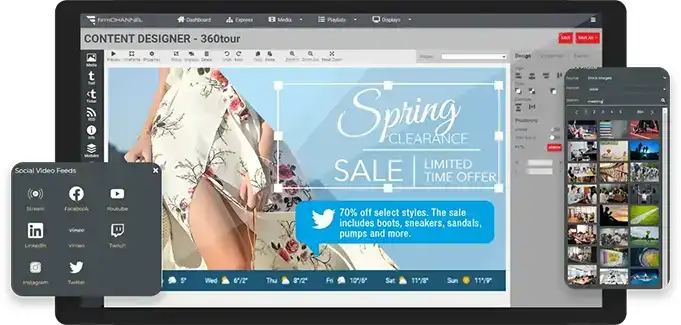How Does Digital Signage Work?
Demystifying Digital Signage: A Closer Look at How It Works
Digital signage represents a leap forward from traditional advertising and information dissemination, blending cutting-edge technology with innovative processes to engage audiences like never before. This blog post aims to demystify how digital signage operates, detailing the technology and processes involved in creating these dynamic displays.
Understanding the Basics
At its core, digital signage operates through a combination of digital displays, media players, and a content management system (CMS). These elements work in tandem to deliver eye-catching, informative content to a variety of audiences across multiple settings, including retail spaces, corporate environments, educational institutions, and public spaces.

The Hardware: Displays and Media Players
Digital Displays: The visible component of digital signage, digital displays use LCD, LED, or projection technology to showcase content. These displays vary in size, brightness, and resolution, tailored to the specific needs of their environment, whether indoor or outdoor.
Media Players: These are the engines behind the digital signage, connecting to displays to feed them content. Media players can be standalone devices or integrated directly into the display. They decode the content sent from the CMS and render it on the screen.
The Software: Content Management System (CMS)
A CMS is the backbone of digital signage, providing the tools necessary to upload, schedule, manage, and deploy content across one or many displays. It’s accessible via the web, allowing users to remotely manage their signage network. Advanced CMS platforms offer drag-and-drop interfaces, template libraries, and scheduling capabilities, making content management both efficient and user-friendly.

The Process: Content Creation to Display
Digital signage can be categorized into several types, each serving unique purposes and applications:
- Content Creation: The first step involves creating or sourcing content, which can range from static images and videos to interactive media. This content is designed to capture attention and convey messages effectively.
- Content Upload and Management: Once created, content is uploaded to the CMS, where it can be organized, scheduled, and assigned to specific displays. This flexibility enables targeted messaging and ensures that the right content reaches the right audience at the optimal time.
- Connectivity and Deployment: The CMS connects to media players through the internet, allowing for the seamless transmission of content. This connection can be wired or wireless, depending on the installation's requirements. Once the content is deployed, it appears on the designated digital displays, ready to engage viewers.
- Interactivity and Real-Time Updates: Modern digital signage systems often include interactive elements, such as touchscreens and QR codes, enabling direct user engagement. Additionally, the CMS can integrate with external data sources, allowing for real-time content updates like news feeds, weather, and social media streams.
- Monitoring and Analytics: A crucial aspect of digital signage is the ability to monitor system health and measure engagement through built-in analytics. This data provides insights into content performance, viewer interactions, and system functionality, helping businesses optimize their digital signage strategies.
- Cloud Integration and SaaS: Many digital signage solutions now leverage cloud technology and Software as a Service (SaaS) models. This approach offers advantages like scalability, remote accessibility, and reduced infrastructure costs. Cloud-based CMS platforms ensure that digital signage networks are always up to date with the latest features and security measures.
Digital signage merges sophisticated technology with creative content management to create captivating visual experiences. From hardware setup and software integration to content creation and deployment, each step is integral to the system's success. By embracing these processes, businesses can effectively communicate with their audiences, offering dynamic and interactive content that informs, entertains, and engages.
We invite you to discover how digital signage can be seamlessly integrated into your business model, addressing unique needs and unlocking new opportunities. For more detailed information and to embark on this transformative journey, visit firmCHANNEL's industry solutions. Here, you'll find insights and examples that resonate with your specific business context, helping you to leverage digital signage technology to its fullest potential.
Connect with an Expert
Why Choose Us?
Innovative Software
Use our cloud-based digital signage software for effortless remote management of your digital screen. Edit your messages and manage your network with just a few clicks, anywhere, anytime.Versatile Hardware Solutions
Find a strong selection of digital display hardware designed to meet every need. Whether you’re looking for indoor and outdoor digital signs, interactive kiosks, or video walls, we have the cutting-edge technology to bring your vision to life.Simplified Content Creation & Deployment
Enhance your messaging with our easy-to-maintain content management system, with AI-enhanced editing tools for easy creation and dynamic content. The flexibility allows you to start creating inspiring things.Unparalleled Support
Benefit from unlimited web training and telephone support with every active subscription. Our dedicated team is committed to ensuring your success and providing you with the support you need, when you need it. firmCHANNEL is recognized as the leading provider of Digital Signage, by companies in Canada, the US. and the rest of the world rely on it.Have a question or want to learn more for your specific project? Send us a message and we will get back to you as soon as we can.
Do you have any questions?

